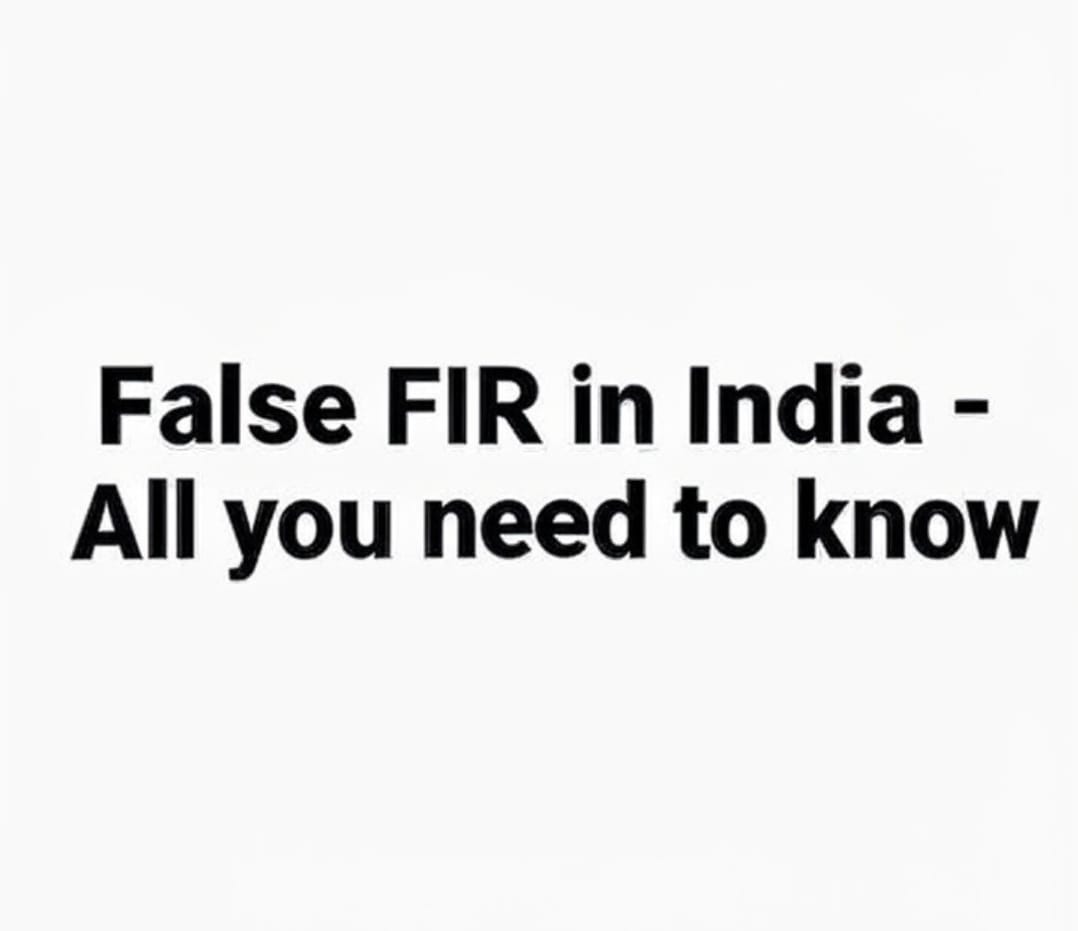INTRODUCTION
When a crime occurs, the first official step in starting an investigation is the filing of an FIR. FIR stands for First Information Report. It is a written document prepared by the police when they receive information about a serious crime, known as a cognizable offence. Cognizable offences are serious crimes like murder, rape, theft, or kidnapping. In such cases, the police have the authority to arrest the accused and initiate the investigation without obtaining permission from a magistrate.
First Information Report was defined previously under Section 154 of the Criminal Procedure Code,1973 and presently under Section 173 of Bharatiya Nagarik Suraksha Sanhita,2023(BNSS).
An FIR can be filed by:
- The victim of the crime
- A witness who saw or knows about the crime
- Any person who knows the offence
WHAT IS A FALSE FIR?
A false FIR (First Information Report) refers to giving false information to the police about a crime that either did not happen or is deliberately misrepresented. A false FIR is intentionally fabricated or lodged with malicious intent, containing untrue allegations, usually meant to harass, intimidate, or settle personal scores. This is done with thw in
Filing a false FIR can cause wrongful arrest for the person who is accused wrongly. It harms the reputation of the accused person.
What happens when FIR is misused?
FIR in the country is meant to protect people; if misused, it can lead to various consequences. For example, if a person falsely accuses one of his classmates or colleagues with the intention of bringing down their reputation, it can damage the other person’s image and also affect their job. By making such allegations and filing an FIR, the accused may get arrested. The allegations must be proved wrong, and only then can the false FIR lead to quashing.
COMMON REASONS TO FILE FALSE FIR
False claims can be submitted for a variety of reasons, including family issues involving marriage, divorce, property, child custody, and other matters.
1. Family disputes
Disputes in the family concerning property, marriage, divorce, or child custody can lead to the filing of a false FIR.
2. Business rivalries
A business individual trying to take down another business competitor to disrupt their operations and gain an advantage might file a false FIR. This can be done to harm the opponent’s reputation or to influence the awarding of contracts.
3. Harassment
People may file a false FIR to threaten another person. It is a tactic used to gain benefits out of revenge, for financial gain, or to intimidate someone.
4. Personal enmity
Individuals might file a false FIR to take revenge for personal reasons. This not only harms the legal system but also causes damage to the person against whom the case is filed.
Section 212 of the Bharatiya Nyaya Sanhita
It deals with the offence of furnishing false information to a public servant. It addresses situations where a person, who is legally obligated to provide information to a public official, knowingly provides false information to such public servant. It includes situations involving officials, police officers, or any other public authority during enquiries.
Punishment for such an offence is imprisonment of up to 6 months or a fine of up to ₹5,000, or both.
Section 216 of the Bharatiya Nyaya Sanhita
It deals with false statements made on oath or affirmation to public authorities. Essentially, it covers the act of perjury if someone knowingly makes a false statement under oath. Such a person can be punished with imprisonment of up to 3 years and a fine.
Section 528 of the BNSS preserves the inherent powers of the High Court, enabling it to make such orders as may be necessary to:
- Give effect to any order under the BNSS;
- Prevent abuse of the process of any Court; or
- Secure the ends of justice.
Legal Remedies For The Victim Of A False Fire
1. Anticipatory Bail under Section 482 of BNSS
Anticipatory bail helps in securing the person before arrest if he thinks that he might be arrested or detained due to the allegations made against him. Anticipatory bail may be taken before the actual arrest in the Sessions Court or the High Court.
2.Quashing of FIR under Section 528 of BNSS
The High Court has been given inherent power under this section to quash any criminal proceedings, which can also include an FIR that is baseless or filed with the wrong intention to cause harm.
3.Complaint against the False Accuser under Section 211 of BNS
A person who has been falsely accused of something can file a complaint against the false accuser under Section 211 of BNS. The person who files the false FIR may be punished for misleading the authorities and initiating false legal action..
4.Seeking Compensation
An individual who is wrongfully implicated in a false FIR may file a suit for compensation on the grounds of malicious prosecution, reputational harm, and financial struggle. In such cases, courts may also award public law compensation, especially if the state or police acted wrongfully.
Procedure For Quashing A False FIR
The process for quashing a fake FIR against someone is meant to keep that person from being detained without a warrant or having to go through an unfair criminal process.Two legal provisions provide a remedy for the falsely accused, who can approach the court and request the quashing of the FIR.
SECTION 528 of BNSS states about Saving of inherent powers of High Court.
Nothing in this Sanhita shall be deemed to limit or affect the inherent powers of the High Court to make such orders as may be necessary to give effect to any order under this Sanhita, or to prevent abuse of the process of any Court or otherwise to secure the ends of justice. this section indicates that the high court has the power to quash the FIR if it is unlawful or misleading.
Article 226 of the Constitution• When a false FIR infringes the accused’s basic rights or amounts to an abuse of the legal system, the High Court may use Article 226 to issue the proper writs to suppress the FIR.
Punishment For Filing a False FIR
From the beginning of the IPC, which is now replaced by the BNS, filing a false FIR that is, providing false information, has resulted in specific or severe penalties. It is discussed in multiple domains.
1. BNS 217 / IPC 182
According to this section, a person may be punished with up to six months in imprisonment, a fine, or both if they intentionally provide a public worker misleading information with the goal of making them do anything unlawful or use their position of authority to harm someone.
This section applies when someone lies to the police intending them to act against another person wrongfully.
2. Section 211 of IPC / Section 248 of BNS
Whoever, being legally bound to give any notice or to furnish information on any subject to any public servant, intentionally omits to give such notice or to furnish such information in the manner and at the time required by law, shall be punished with simple imprisonment for a term which may extend to one month, or with fine which may extend to five thousand rupees, or with both.
3. Section 229 of the BNS and Section 193 of the IPC
Anyone who willfully provides false testimony in a court of law or creates false testimony to be used in any stage of a court case faces up to seven years in prison of any kind and a fine of up to ten thousand rupees.
Filing of a false FIR can also be treated as contempt of court as it may mislead the court, cause delay in providing justice, and also waste the court’s time. It is a punishable offence under the Contempt of Courts Act, 1971.
Role of Police and Judiciary in Curbing False FIRs
The role of the police and judiciary is very important in addressing fake FIRs. The police look into the investigation of complaints and registration, while the judiciary has the power to quash false FIRs and punish those who file them with wrong intentions. The police are obliged to follow the regulations and guidelines mentioned in Section 41A of the CrPC, which ensures the rights of the arrested person and makes sure that arrests are not arbitrary. The police are responsible for registering FIRs and conducting investigations.
1. Investigation
2. Register FIR
3. Avoid misuse of the law while reporting to the court
4. Maintaining balance
The police are supposed to register the FIR given by the complainant. This was also upheld in the case of Lalita Kumari v. Government of Uttar Pradesh. They are bound to register the FIR, but it is equally important that the police carefully examine the investigation reports to ensure there is no misuse of the law and to secure a fair trial. The police must determine whether the allegations made are genuine or fake. They should collect sufficient evidence and cross-check every single detail. The police must also submit the charge sheet to the magistrate.
IMPORTANT CASE LAWS
1. State of Haryana v. Bhajan Lal (1992 Supp (1) SCC 335)
Bhajan Lal, a former Chief Minister, was accused of corruption on the allegation that he had illegal wealth and disproportionate income. An FIR was filed against him. Bhajan Lal approached the High Court to quash the FIR. The Supreme Court held that the High Court or the Supreme Court has inherent powers under Section 482 of the CrPC to quash any FIR that is misleading.
2. Zandu Pharmaceutical Works Ltd. v. Mohd. Sharaful Haque (2005 SCC (Cri) 283)
The plaintiff was assigned to a different position despite applying for the position of Area Manager. In 2002, he filed a complaint under Sections 406, 409, and 418 of the IPC, alleging this. Under Section 482 of the CrPC, the business contested the order. Because the complaint was precluded by limitation under Section 468 of the CrPC, the Supreme Court annulled the proceedings. The disagreement amounted to an abuse of process and was civil in nature.
3. M/s Pepsi Foods Ltd. v. Special Judicial Magistrate (1998 (5) SCC 749)
In 1993, a customer complained that a bottle of Lehar Pepsi was tampered with. Twelve defendants, including Pepsi Foods Ltd. and its directors, were summoned by the magistrate. Pepsi filed a challenge against this order in the Allahabad High Court, but the petition was denied. The Supreme Court dismissed the complaint and proceedings after an appeal, concluding that summoning an accused person is a serious matter that needs to be backed up by appropriate judicial review. The High Court was also chastised by the Court for improperly using its judicial authority.
Conclusion
FIR in India is a part of the justice system that gives people the right to fight for their protection, take legal steps to safeguard their rights, and seek protection under the law. But if the same is misused to defame, harass, or mislead the proceedings, it can be considered a serious offence. Filing a false FIR can put the innocent in trouble and also affect the judicial system. There is anticipatory bail and FIR quashing; these things can be avoided as there are also a few remedies for it. But it is in the hands of the police and judiciary to make sure that a false FIR is not filed and to recognize such false cases. Only by maintaining this can we avoid the misuse of such offences and ensure that the judiciary gives fair and equal treatment to everyone so that all of us can get equal justice.
About Author
Chaithanya, a law student at Ramaiah Institute of Legal Studies, is deeply passionate about Intellectual Property Rights, Corporate Law, and Constitutional Law. She is keen on building strong research expertise in these fields and exploring contemporary legal developments. With a commitment to continuous growth, she aspires to contribute meaningful insights to the legal community.

